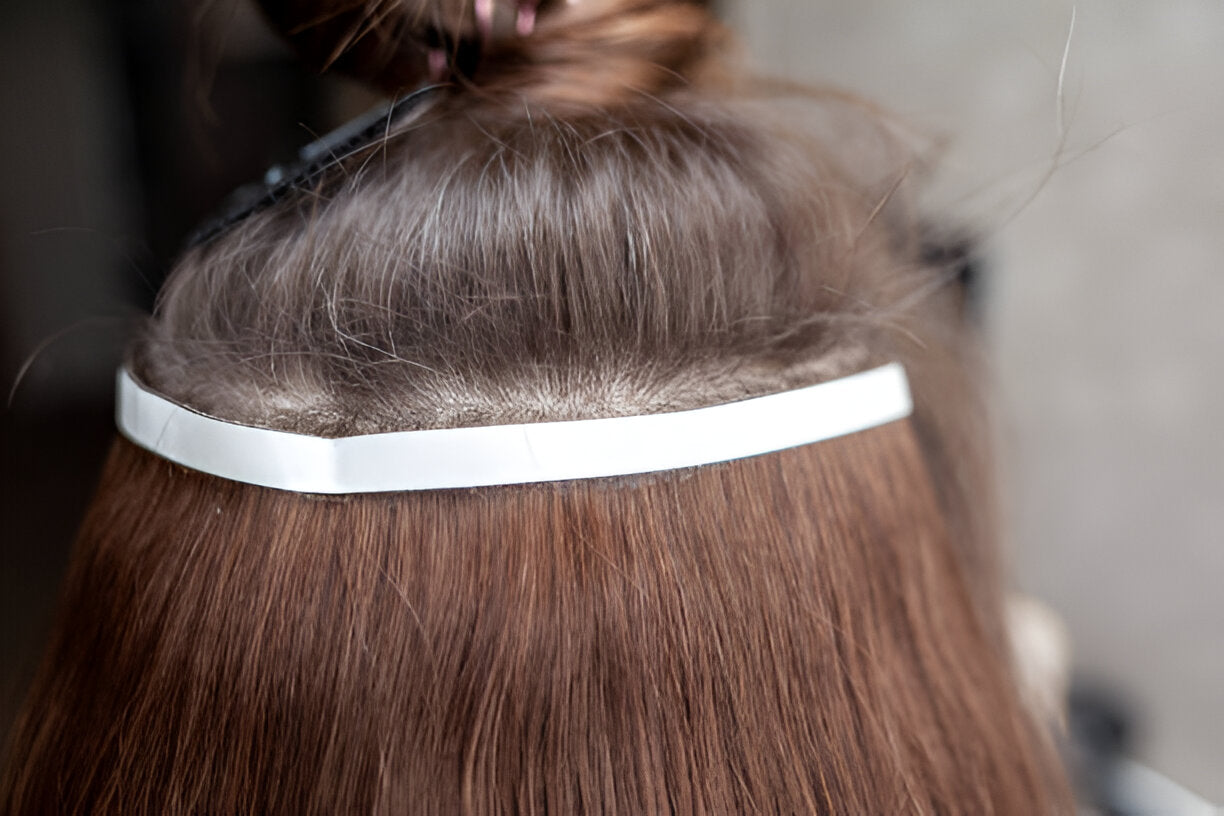Applying tape in hair extensions can significantly transform your appearance by adding both length and volume to your hair. This method is celebrated for its convenience and natural-looking results. Unlike permanent extensions, tape in extensions offer a non-committal way to enhance your hairstyle. This guide will explore every aspect of applying tape in hair extensions, from initial preparation to everyday care, helping you achieve and maintain the look you desire.
How to Apply Tape in Hair Extensions for a Seamless Look
Applying tape in hair extensions involves a straightforward process, but achieving a flawless finish requires attention to detail. Here’s a detailed guide to help you apply them seamlessly.
Preparing Your Hair for Tape-In Extensions
Preparation is crucial for a successful application of tape in extensions.
- Wash and Dry Your Hair: Start by washing your hair with a clarifying shampoo to remove any buildup of oils and product residues. Avoid using conditioner, as it can leave a film that may interfere with the adhesive of the extensions. After washing, let your hair dry completely. Tape-in extensions adheres best to clean, dry hair.
- Brush Thoroughly: Using a high-quality hairbrush, carefully brush your hair to eliminate any knots or tangles. This ensures a smooth application and helps the extensions blend seamlessly with your natural hair. Knots can cause the extensions to clump or look unnatural.
- Section Your Hair: To make the application process easier, divide your hair into sections using clips. Start with the bottom layer and gradually work your way up. This helps in applying the extensions evenly and avoids overlapping.
Applying the Extensions
Now that your hair is prepared, you can begin applying the tape to the extensions.
- Align the Extensions: Position the tape extension at the root of the sectioned hair. Ensure that it is aligned correctly with your natural hair. It’s important not to place the tape too close to the scalp to avoid discomfort and to allow for natural hair growth.
- Press Firmly: Once you’ve positioned the extension, press it firmly against your natural hair. Ensure there are no gaps between the tape and your hair. A firm press will help the extension adhere better and last longer. Using a tool like a hair extension application tool or a comb can help in pressing the extension evenly.
- Avoid Overlap: Make sure the tape extensions are applied without overlapping. Overlapping can create bulkiness and make the extensions more noticeable, which can detract from a natural look. Aligning them correctly will ensure a smooth and seamless finish.
Securing the Extensions
To ensure that the tape in extensions stays in place, follow these additional steps:
- Use Heat: Gently heat the taped area using a hair straightener set to a low temperature. The heat activates the adhesive and helps it bond more effectively with your natural hair. Be careful not to use too much heat, as it could damage both the extensions and your natural hair.
- Allow to Set: After applying heat, refrain from washing or wetting your hair for at least 48 hours. This waiting period is essential for allowing the adhesive to set fully and create a stronger bond. During this time, avoid swimming or exposing your hair to excessive moisture.
Can You Shower with Tape in Extensions?
Yes, you can shower with tape-in extensions, but it’s important to follow some guidelines to maintain their longevity and appearance.

Tips for Showering with Tape In Extensions
- Use Gentle Products: Opt for sulfate-free shampoos and conditioners. Sulfates can weaken the adhesive and reduce the lifespan of your extensions. Look for products specifically designed for colour-treated or delicate hair to help maintain the bond and keep your extensions looking great.
- Avoid Hot Water: Hot water can affect the adhesive’s strength and may lead to premature loosening of the extensions. Use lukewarm water to gently wash your hair.
- Pat Dry: After showering, gently pat your hair dry with a towel instead of rubbing it. Rubbing can cause tangling and stress on the extensions, which might lead to them coming loose or becoming damaged.
- Avoid Excessive Heat: After drying, try to limit the use of heat styling tools. If you must use them, make sure to apply a heat protectant to prevent damage.
Tape In Extensions on Black Hair: What You Need to Know
Tape in extensions are suitable for black hair, but ensuring a natural and seamless blend involves specific considerations. Here’s how you can achieve the best results.
Choosing the Right Tape In Extensions
- Color Matching: When selecting tape in extensions for black hair, it’s crucial to find a shade that matches your natural hair color closely. Many brands offer a wide range of shades to help you find the perfect match. If your hair has highlights or lowlights, choose extensions that blend well with these variations.
- Texture Consideration: Opt for high-quality, 100% Remy human hair extensions. Remy hair is known for its natural look and feel and can be styled just like your own hair. This ensures that the extensions will blend well with your natural texture, whether your hair is straight, wavy, or curly.
Maintenance Tips for Black Hair Extensions
- Use Suitable Products: Choose hair care products specifically formulated for black or textured hair. These products will help maintain the health and appearance of both your natural hair and the extensions. Avoid products with harsh chemicals that can dry out or damage the hair.
- Regular Conditioning: Even though tape in extensions do not require daily conditioning, applying a deep conditioner once a week can help keep the hair moisturized and healthy. Avoid applying conditioner directly to the roots where the extensions are attached to prevent loosening.
- Avoid Excessive Heat: Minimize the use of heat styling tools, such as flat irons and curling wands. When you do use them, apply a heat protectant spray to shield the hair from damage and ensure the longevity of the extensions.
Tape on Extensions vs. Tape In Extensions: What’s the Difference?
Understanding the differences between tape on and tape in extensions can help you make an informed decision about which type is best for you.
Benefits of Tape In Extensions
- Long-Lasting Hold: Tape in extensions are known for their durability and long-lasting hold. They typically last between 6 to 8 weeks before requiring re-taping or replacement. This makes them a more reliable option compared to other types of extensions.
- Natural Look: Tape in extensions provide a more natural look because they are applied in small sections. This method ensures that the extensions blend seamlessly with your natural hair, making them less noticeable.
Comparing Application Methods
- Tape In Extensions: These extensions are applied by sandwiching your natural hair between two pieces of tape. This method creates a strong and discreet bond that provides a secure fit.
- Tape On Extensions: Tape on extensions use a single piece of adhesive tape, which can be less durable. This method may not adhere as securely and can be more noticeable compared to tape in extensions.
- Comfort Level: Tape in extensions tend to be more comfortable for extended wear as they are less likely to cause discomfort or irritation compared to tape on extensions, which might create bulkiness and be more noticeable.
How Do They Make Wigs with Human Hair?
Human hair wigs are designed to provide a natural look and feel. The creation process involves several detailed steps to ensure high quality.

The Hair Preparation Process
- Collection and Sorting: Human hair used for wigs is collected from donors and sorted based on various criteria, including texture, color, and quality. Sorting ensures that the final product is consistent and meets high standards.
- Cleaning and Treatment: The collected hair is thoroughly cleaned and treated to remove impurities. This process involves washing, conditioning, and sometimes dyeing the hair to achieve the desired shade and quality.
Constructing the Wig Base
- Base Material: The wig base is crafted from a breathable material that molds to the shape of the wearer’s head. This base is designed to be comfortable and provide a secure fit. It may be made from lace, silk, or other lightweight materials.
- Attaching the Hair: The prepared hair is meticulously sewn or glued onto the base. The hair is arranged to mimic natural growth patterns and density, creating a realistic appearance. Attention is given to the direction and distribution of the hair to ensure a natural look.
FAQs
How long do tape extensions last?
Tape-in extensions typically last between 6 to 8 weeks before they need to be re-taped or replaced. Regular maintenance and proper care can help extend their lifespan.
Can I style tape in extensions?
Yes, you can style tape in extensions just like your natural hair. Whether you want to straighten, curl, or add volume, you can use heat styling tools. Just remember to use a heat protectant to prevent damage and avoid applying excessive heat directly on the tape.
Are tape extensions suitable for all hair types?
Tape in extensions are versatile and can be used on various hair types, including straight, wavy, and curly hair. However, selecting the right type of extension and following proper application techniques is crucial for achieving the best results.
Conclusion
Applying tape in hair extensions is an effective way to achieve longer, fuller hair with a natural appearance. By following the proper application and maintenance techniques, you can enjoy beautiful, voluminous hair without the commitment of permanent extensions. Whether you’re new to tape in extensions or seeking to maintain your existing ones, these tips will help you achieve and maintain the best possible results, ensuring your hair always looks stunning.


